Boosting Photovoltaic Performance in Organic Solar Cells by Manipulating the Size of MoS2 Quantum Dots as a Hole-Transport Material
Abstract
1. Introduction
2. Materials and Methods
2.1. Preparation of MoS2 QDs
2.2. Device Fabrication
2.3. Characterizations
3. Results and Discussion
4. Conclusions
Supplementary Materials
Author Contributions
Funding
Conflicts of Interest
References
- Manzeli, S.; Ovchinnikov, D.; Pasquier, D.; Yazyev, O.V.; Kis, A. 2D transition metal dichalcogenides. Nat. Rev. Mater. 2017, 2, 17033. [Google Scholar] [CrossRef]
- Wang, S.; Robertson, A.; Warner, J.H. Atomic structure of defects and dopants in 2D layered transition metal dichalcogenides. Chem. Soc. Rev. 2018, 47, 6764–6794. [Google Scholar] [CrossRef] [PubMed]
- Voiry, D.; Mohite, A.; Chhowalla, M. Phase engineering of transition metal dichalcogenides. Chem. Soc. Rev. 2015, 44, 2702–2712. [Google Scholar] [CrossRef] [PubMed]
- Duan, X.; Wang, C.; Pan, A.; Yu, R.; Duan, X. Two-dimensional transition metal dichalcogenides as atomically thin semiconductors: Opportunities and challenges. Chem. Soc. Rev. 2015, 44, 8859–8876. [Google Scholar] [CrossRef]
- Yip, H.-L.; Jen, A.K.-Y. Recent advances in solution-processed interfacial materials for efficient and stable polymer solar cells. Energy Environ. Sci. 2012, 5, 5994–6011. [Google Scholar] [CrossRef]
- Lin, S.; Liu, S.; Yang, Z.; Li, Y.; Ng, T.W.; Xu, Z.; Bao, Q.; Hao, J.; Lee, C.S.; Surya, C. Solution-processable ultrathin black phosphorus as an effective electron transport layer in organic photovoltaics. Adv. Funct. Mater. 2016, 26, 864–871. [Google Scholar] [CrossRef]
- Chen, S.; Manders, J.R.; Tsang, S.-W.; So, F. Metal oxides for interface engineering in polymer solar cells. J. Mater. Chem. 2012, 22, 24202–24212. [Google Scholar] [CrossRef]
- Gu, X.; Cui, W.; Li, H.; Wu, Z.; Zeng, Z.; Lee, S.T.; Zhang, H.; Sun, B. A Solution-processed hole extraction layer made from ultrathin MoS2 nanosheets for efficient organic solar cells. Adv. Energy Mater. 2013, 3, 1262–1268. [Google Scholar] [CrossRef]
- Yun, J.M.; Noh, Y.J.; Lee, C.H.; Na, S.I.; Lee, S.; Jo, S.M.; Joh, H.I.; Kim, D.Y. Exfoliated and partially oxidized MoS2 nanosheets by one-pot reaction for efficient and stable organic solar cells. Small 2014, 10, 2319–2324. [Google Scholar] [CrossRef]
- Van Le, Q.; Nguyen, T.P.; Jang, H.W.; Kim, S.Y. The use of UV/ozone-treated MoS2 nanosheets for extended air stability in organic photovoltaic cells. Phys. Chem. Chem. Phys. 2014, 16, 13123–13128. [Google Scholar]
- Yun, J.-M.; Noh, Y.-J.; Yeo, J.-S.; Go, Y.-J.; Na, S.-I.; Jeong, H.-G.; Kim, J.; Lee, S.; Kim, S.-S.; Koo, H.Y. Efficient work-function engineering of solution-processed MoS2 thin-films for novel hole and electron transport layers leading to high-performance polymer solar cells. J. Mater. Chem. C 2013, 1, 3777–3783. [Google Scholar] [CrossRef]
- Liu, W.; Yang, X.; Zhang, Y.; Xu, M.; Chen, H. Ultra-stable two-dimensional MoS2 solution for highly efficient organic solar cells. RSC Adv. 2014, 4, 32744–32748. [Google Scholar] [CrossRef]
- de Arquer, F.P.G.; Armin, A.; Meredith, P.; Sargent, E.H. Solution-processed semiconductors for next-generation photodetectors. Nat. Rev. Mater. 2017, 2, 1–17. [Google Scholar] [CrossRef]
- Pan, Z.; Rao, H.; Mora-Seró, I.; Bisquert, J.; Zhong, X. Quantum dot-sensitized solar cells. Chem. Soc. Rev. 2018, 47, 7659–7702. [Google Scholar] [CrossRef]
- An, Q.; Zhang, F.; Zhang, J.; Tang, W.; Deng, Z.; Hu, B. Versatile ternary organic solar cells: A critical review. Energy Environ. Sci. 2016, 9, 281–322. [Google Scholar] [CrossRef]
- Sargent, E.H. Colloidal quantum dot solar cells. Nat. Photonics 2012, 6, 133–135. [Google Scholar] [CrossRef]
- Sargent, E.H. Solar cells, photodetectors, and optical sources from infrared colloidal quantum dots. Adv. Mater. 2008, 20, 3958–3964. [Google Scholar] [CrossRef]
- Yuan, M.; Liu, M.; Sargent, E.H. Colloidal quantum dot solids for solution-processed solar cells. Nat. Energy 2016, 1, 1–9. [Google Scholar] [CrossRef]
- Li, T.-L.; Lee, Y.-L.; Teng, H. High-performance quantum dot-sensitized solar cells based on sensitization with CuInS2 quantum dots/CdS heterostructure. Energy Environ. Sci. 2012, 5, 5315–5324. [Google Scholar] [CrossRef]
- Pan, Z.; Mora-Seró, I.N.; Shen, Q.; Zhang, H.; Li, Y.; Zhao, K.; Wang, J.; Zhong, X.; Bisquert, J. High-efficiency “green” quantum dot solar cells. J. Am. Chem. Soc. 2014, 136, 9203–9210. [Google Scholar] [CrossRef] [PubMed]
- Najafi, L.; Taheri, B.; Martín-García, B.; Bellani, S.; Di Girolamo, D.; Agresti, A.; Oropesa-Nunez, R.; Pescetelli, S.; Vesce, L.; Calabro, E. MoS2 quantum dot/graphene hybrids for advanced interface engineering of a CH3NH3PbI3 perovskite solar cell with an efficiency of over 20%. ACS Nano 2018, 12, 10736–10754. [Google Scholar] [CrossRef]
- Xing, W.; Chen, Y.; Wang, X.; Lv, L.; Ouyang, X.; Ge, Z.; Huang, H. MoS2 quantum dots with a tunable work function for high-performance organic solar cells. ACS Appl. Mater. Interfaces 2016, 8, 26916–26923. [Google Scholar] [CrossRef]
- Sarswat, P.K.; Free, M.L. Light emitting diodes based on carbon dots derived from food, beverage, and combustion wastes. Phys. Chem. Chem. Phys. 2015, 17, 27642–27652. [Google Scholar] [CrossRef] [PubMed]
- Kabel, J.; Sharma, S.; Acharya, A.; Zhang, D.; Yap, Y.K. Molybdenum Disulfide Quantum Dots: Properties, Synthesis, and Applications. C 2021, 7, 45. [Google Scholar]
- Dong, H.; Tang, S.; Hao, Y.; Yu, H.; Dai, W.; Zhao, G.; Cao, Y.; Lu, H.; Zhang, X.; Ju, H. Fluorescent MoS2 Quantum Dots: Ultrasonic Preparation, Up-Conversion and Down-Conversion Bioimaging, and Photodynamic Therapy. ACS Appl. Mater. Interfaces 2016, 8, 3107–3114. [Google Scholar] [CrossRef] [PubMed]
- Park, K.H.; An, Y.; Jung, S.; Park, H.; Yang, C. Locking-in optimal nanoscale structure induced by naphthalenediimide-based polymeric additive enables efficient and stable inverted polymer solar cells. ACS Nano 2017, 11, 7409–7415. [Google Scholar] [CrossRef]
- Yang, L.; Cui, X.; Zhang, J.; Wang, K.; Shen, M.; Zeng, S.; Dayeh, S.A.; Feng, L.; Xiang, B. Lattice strain effects on the optical properties of MoS2 nanosheets. Sci. Rep. 2014, 4, 5649. [Google Scholar] [CrossRef]
- Liang, L.; Meunier, V. First-principles Raman spectra of MoS2, WS2 and their heterostructures. Nanoscale 2014, 6, 5394–5401. [Google Scholar] [CrossRef]
- Liu, Y.; Nan, H.; Wu, X.; Pan, W.; Wang, W.; Bai, J.; Zhao, W.; Sun, L.; Wang, X.; Ni, Z. Layer-by-Layer Thinning of MoS2 by Plasma. ACS Nano 2013, 7, 4202–4209. [Google Scholar] [CrossRef] [PubMed]
- Park, K.H.; An, Y.; Jung, S.; Park, H.; Yang, C. The use of an n-type macromolecular additive as a simple yet effective tool for improving and stabilizing the performance of organic solar cells. Energy Environ. Sci. 2016, 9, 3464–3471. [Google Scholar] [CrossRef]
- Lee, S.M.; Park, K.H.; Jung, S.; Park, H.; Yang, C. Stepwise heating in Stille polycondensation toward no batch-to-batch variations in polymer solar cell performance. Nat. Commun. 2018, 9, 1–8. [Google Scholar] [CrossRef] [PubMed]
- Sun, Y.; Takacs, C.J.; Cowan, S.R.; Seo, J.H.; Gong, X.; Roy, A.; Heeger, A.J. Efficient, Air-Stable Bulk Heterojunction Polymer Solar Cells Using MoOx as the Anode Interfacial Layer. Adv. Mater. 2011, 23, 2226–2230. [Google Scholar] [CrossRef] [PubMed]
- Chen, L.-M.; Xu, Z.; Hong, Z.; Yang, Y. Interface investigation and engineering—Achieving high performance polymer photovoltaic devices. J. Mater. Chem. 2010, 20, 2575–2598. [Google Scholar] [CrossRef]
- Sun, C.; Qin, S.; Wang, R.; Chen, S.; Pan, F.; Qiu, B.; Shang, Z.; Meng, L.; Zhnag, C.; Xiao, M.; et al. High efficiency polymer solar cells with efficient hole transfer at zero highest occupied molecular orbital offset between methylated polymer donor and brominated acceptor. J. Am. Chem. Soc. 2020, 142, 1465–1474. [Google Scholar] [CrossRef] [PubMed]
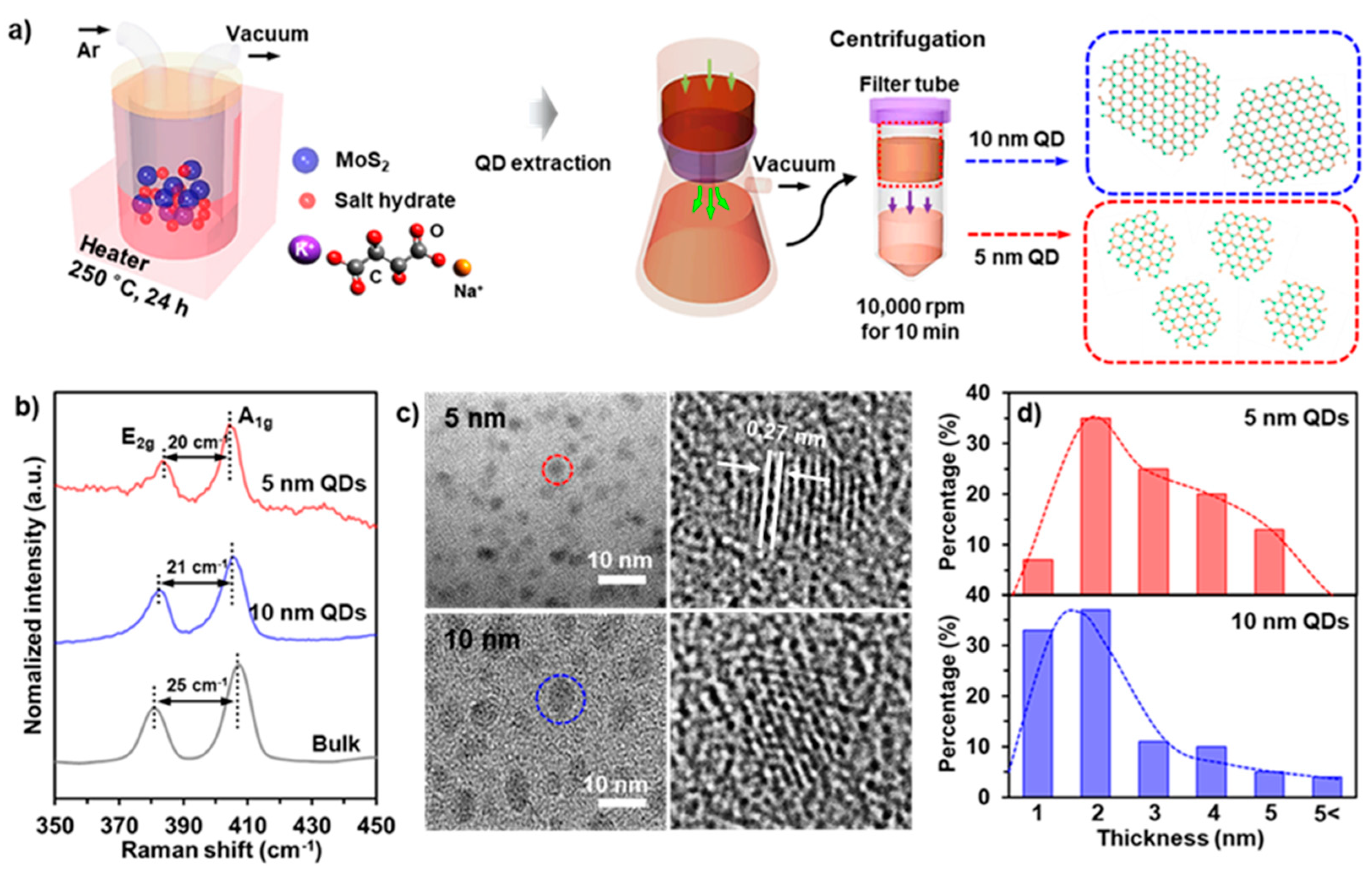
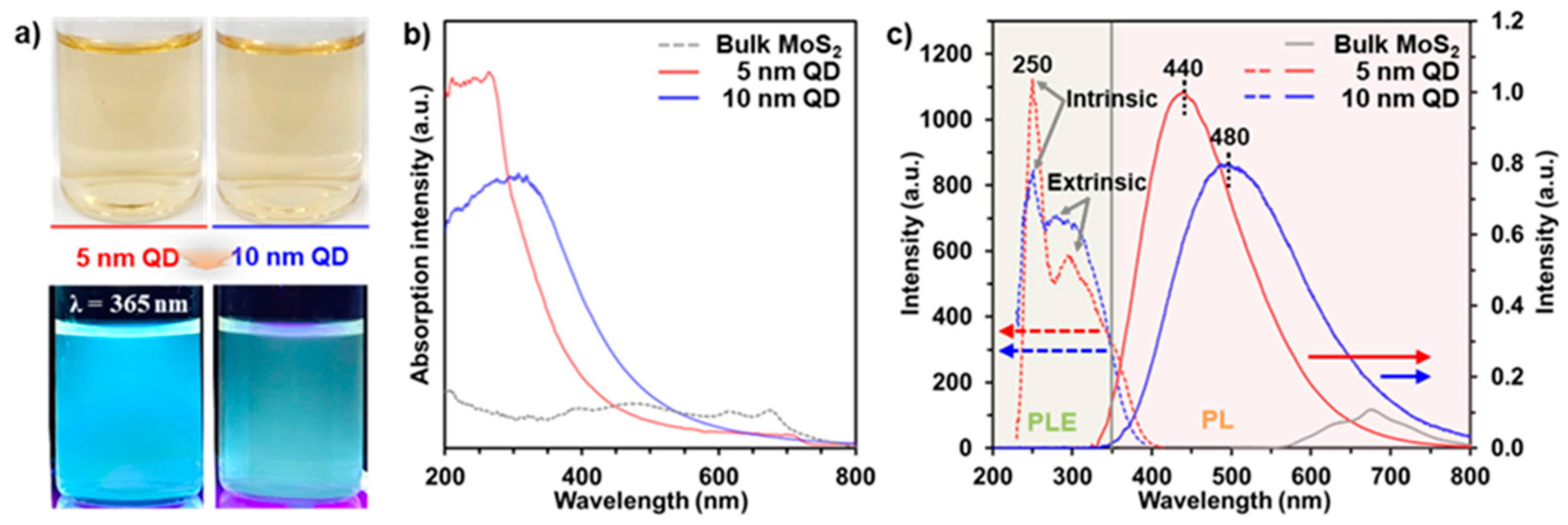
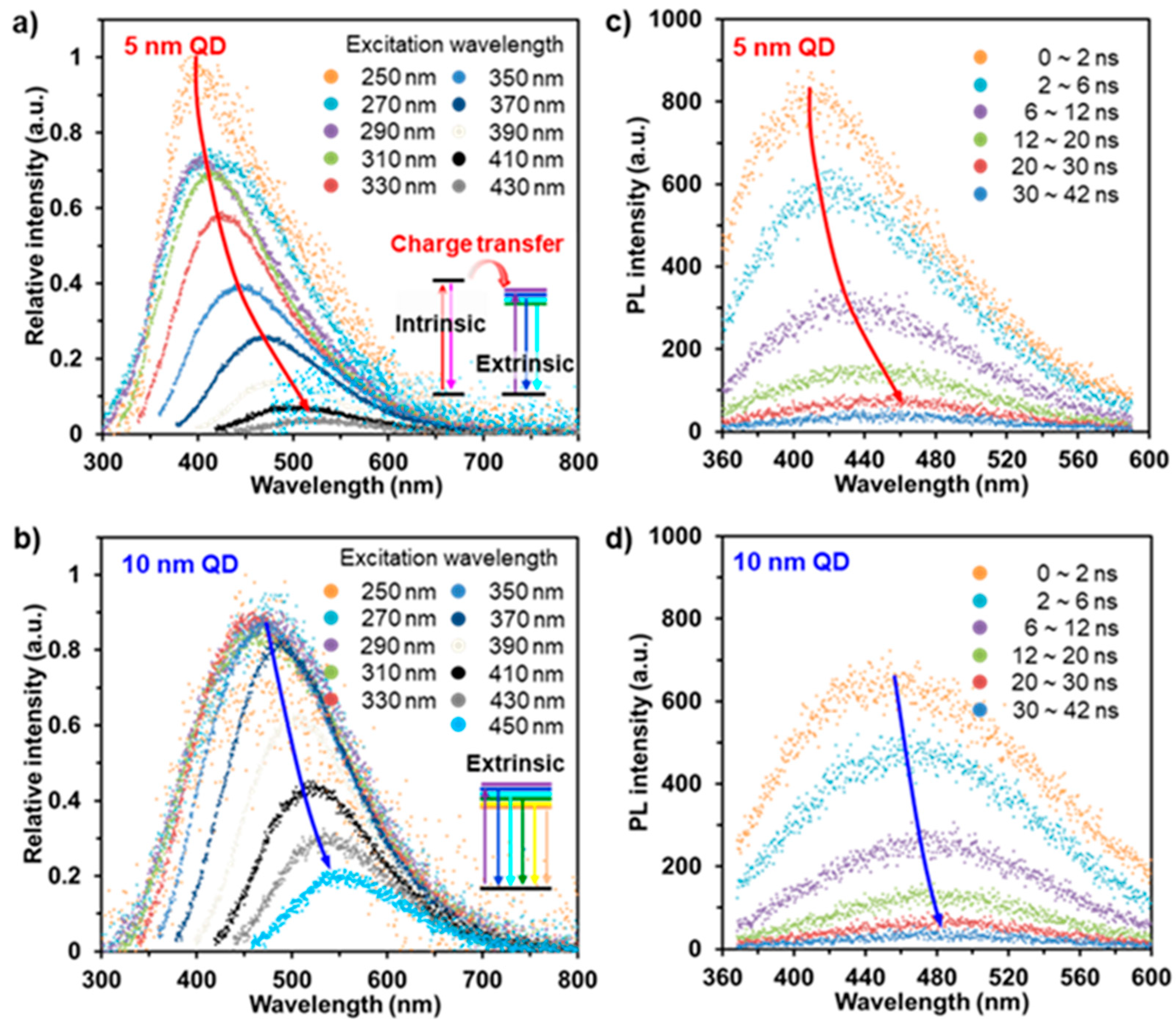
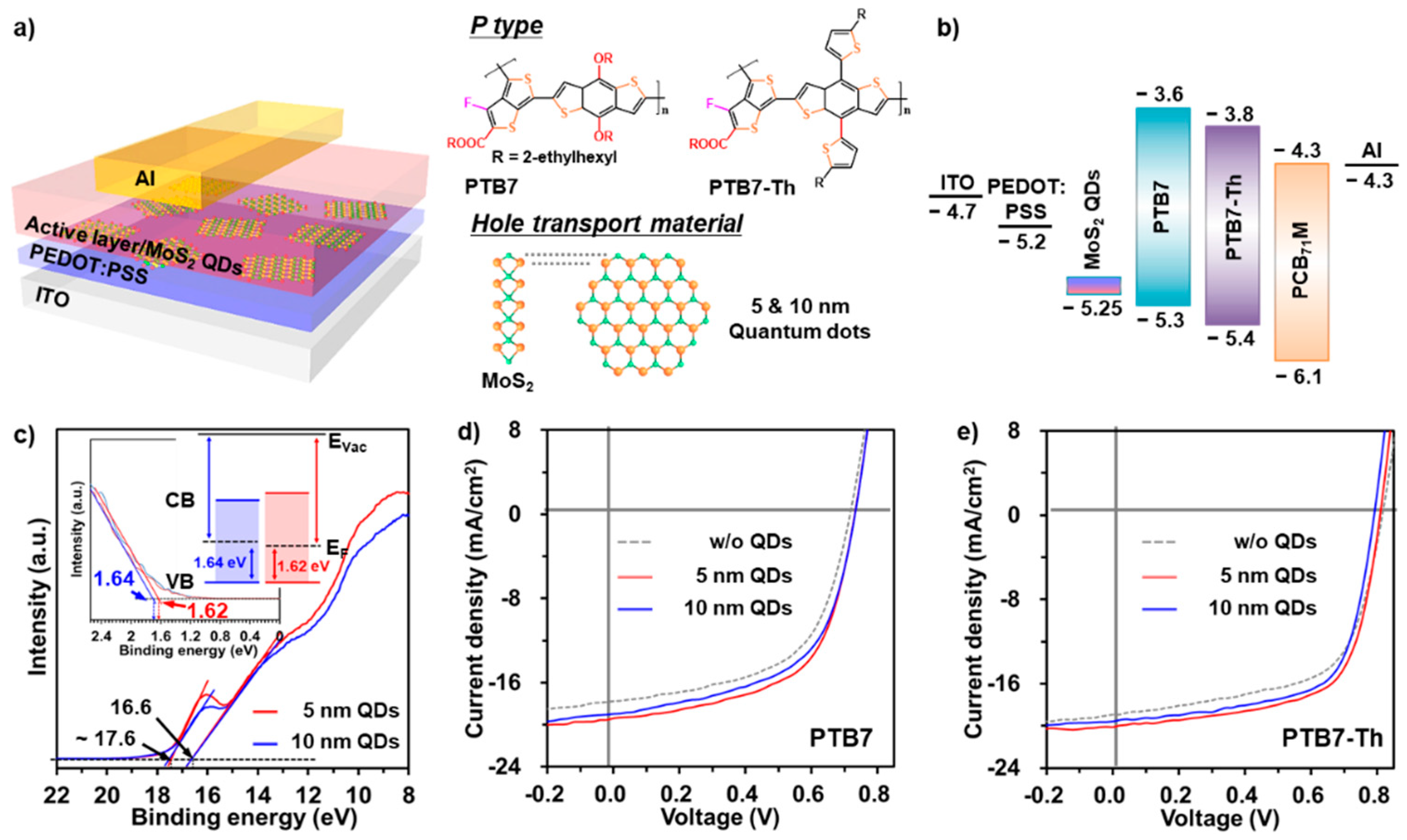
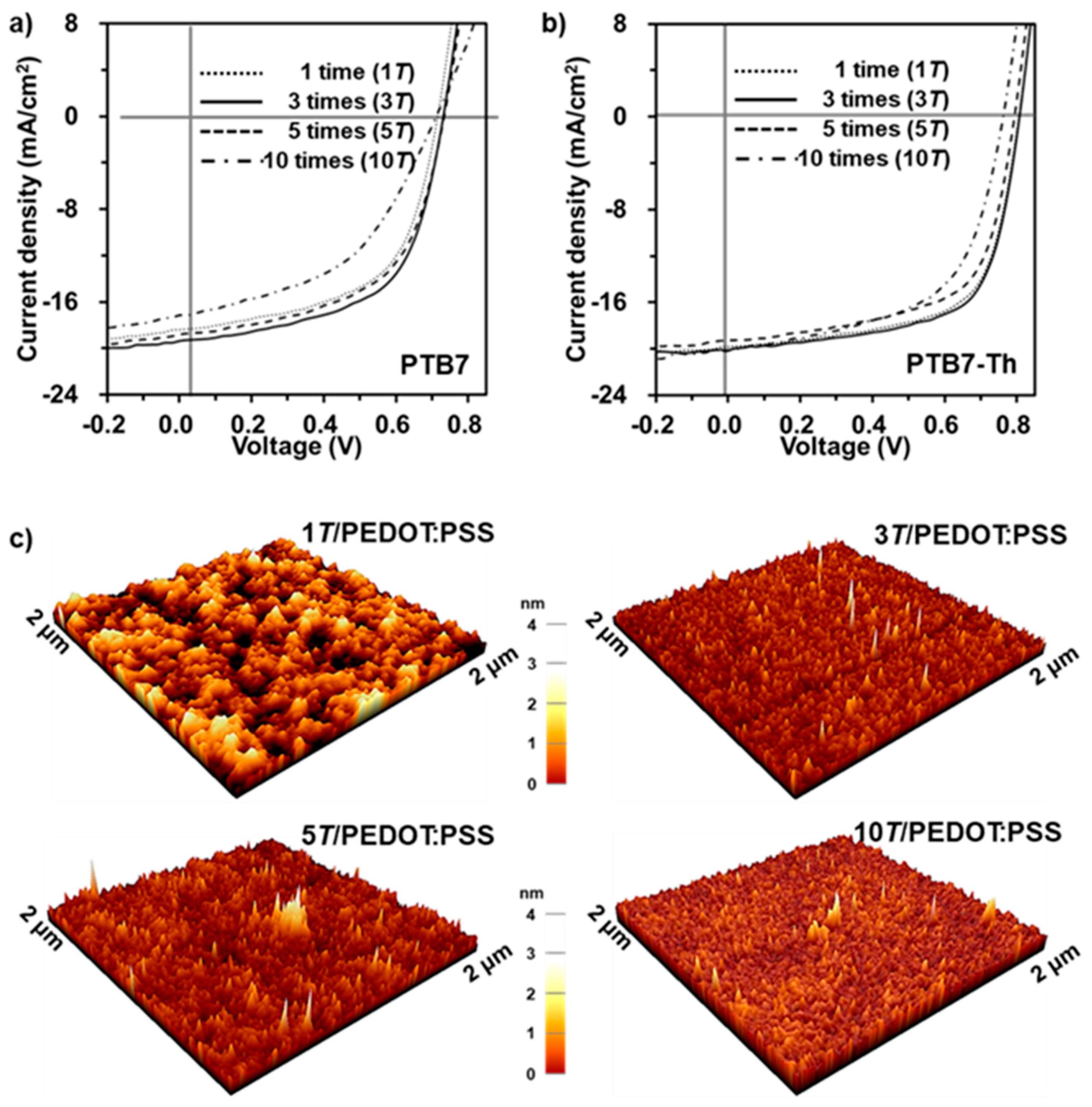
| Active Materials | Hole-Transport Layer | JSC (mA cm−2) | VOC (V) | FF (%) | Avg. PCE (%) |
|---|---|---|---|---|---|
| PTB7 | w/o MoS2 QD | 17.8 ± 0.3 | 0.71 ± 0.01 | 56 ± 1 | 7.24 |
| 5 nm MoS2 QD | 19.2 ± 0.2 | 0.73 ± 0.01 | 59 ± 1 | 8.32 | |
| 10 nm MoS2 QD | 19.0 ± 0.2 | 0.72 ± 0.01 | 59 ± 1 | 7.80 | |
| PTB7-Th | w/o MoS2 QD | 18.9 ± 0.2 | 0.80 ± 0.02 | 60 ± 2 | 9.49 |
| 5 nm MoS2 QD | 20.1 ± 0.2 | 0.80 ± 0.01 | 65 ± 1 | 10.57 | |
| 10 nm MoS2 QD | 19.6 ± 0.3 | 0.79 ± 0.01 | 65 ± 1 | 10.17 |
Publisher’s Note: MDPI stays neutral with regard to jurisdictional claims in published maps and institutional affiliations. |
© 2021 by the authors. Licensee MDPI, Basel, Switzerland. This article is an open access article distributed under the terms and conditions of the Creative Commons Attribution (CC BY) license (https://creativecommons.org/licenses/by/4.0/).
Share and Cite
Park, K.H.; Jung, S.; Kim, J.; Ko, B.-M.; Shim, W.-G.; Hong, S.-J.; Song, S.H. Boosting Photovoltaic Performance in Organic Solar Cells by Manipulating the Size of MoS2 Quantum Dots as a Hole-Transport Material. Nanomaterials 2021, 11, 1464. https://doi.org/10.3390/nano11061464
Park KH, Jung S, Kim J, Ko B-M, Shim W-G, Hong S-J, Song SH. Boosting Photovoltaic Performance in Organic Solar Cells by Manipulating the Size of MoS2 Quantum Dots as a Hole-Transport Material. Nanomaterials. 2021; 11(6):1464. https://doi.org/10.3390/nano11061464
Chicago/Turabian StylePark, Kwang Hyun, Sunggyeong Jung, Jungmo Kim, Byoung-Min Ko, Wang-Geun Shim, Soon-Jik Hong, and Sung Ho Song. 2021. "Boosting Photovoltaic Performance in Organic Solar Cells by Manipulating the Size of MoS2 Quantum Dots as a Hole-Transport Material" Nanomaterials 11, no. 6: 1464. https://doi.org/10.3390/nano11061464
APA StylePark, K. H., Jung, S., Kim, J., Ko, B.-M., Shim, W.-G., Hong, S.-J., & Song, S. H. (2021). Boosting Photovoltaic Performance in Organic Solar Cells by Manipulating the Size of MoS2 Quantum Dots as a Hole-Transport Material. Nanomaterials, 11(6), 1464. https://doi.org/10.3390/nano11061464






